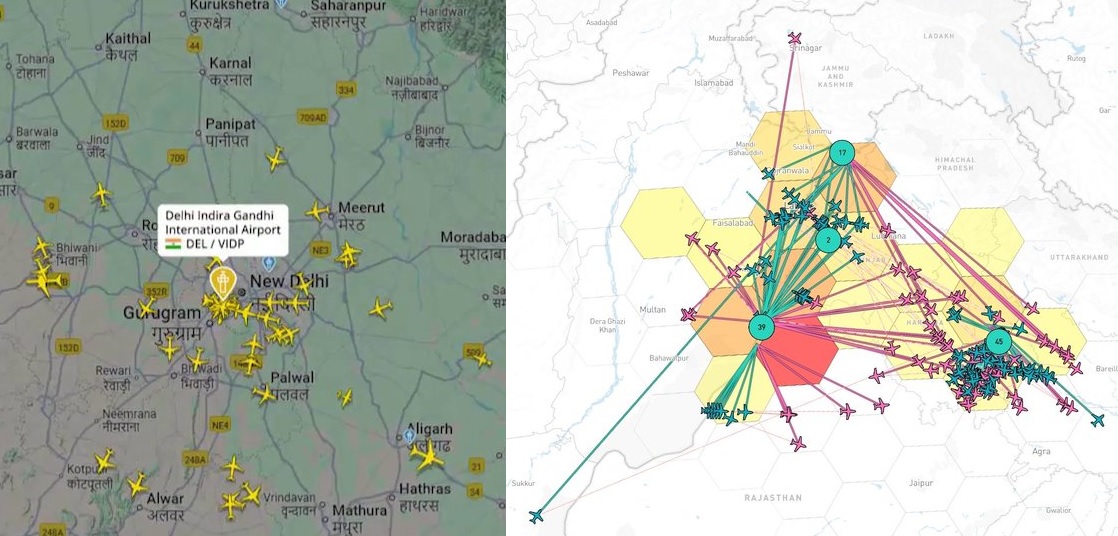Unusual GPS Spoofing Surge Disrupts Flights Over Delhi and India–Pakistan Border

Over the past few days, India’s skies have witnessed a wave of GPS spoofing incidents—a sophisticated form of signal manipulation that has caused serious disruption to air traffic, particularly around Delhi’s Indira Gandhi International Airport (IGIA) and the India–Pakistan border. The phenomenon, previously confined to conflict zones like Ukraine and the Middle East, now appears to be affecting Indian airspace, raising deep concerns about both aviation safety and national security.
According to flight tracking data and reports from pilots, more than 400 flights were grounded or delayed for up to two hours, as aircraft approaching Delhi began to experience erratic navigation readings. Pilots described seeing sudden jumps in altitude and position, with aircraft computers reporting inaccurate coordinates—classic symptoms of a GPS spoofing attack.
What Exactly Is GPS Spoofing?
Unlike a typical GPS “jammer,” which simply blocks satellite signals, GPS spoofing is an advanced deception technique. It involves transmitting counterfeit satellite signals that overpower the genuine ones, tricking aircraft receivers into calculating false positions or altitudes.
In essence, it’s like replacing a pilot’s map with a fake one—accurate enough to look believable, but slightly altered to mislead navigation. For aircraft performing RNP (Required Navigation Performance) approaches that rely on satellite data, this can create dangerous flight path deviations during critical phases such as landing.
How Attackers Do It
Spoofing can be conducted using portable transmitters, often built from off-the-shelf software-defined radios and open-source GNSS signal generators. These devices can broadcast false GPS signals powerful enough to mislead receivers within a range of several kilometers.
Some advanced systems, likely state-sponsored, can coordinate matched-signal spoofing, synchronizing with legitimate satellite timing to gradually shift aircraft off their true path without immediate detection.
Such capabilities are often found in electronic warfare units or military-grade jamming systems, several of which have been observed deployed by neighboring countries near sensitive borders.
The Impact on Aviation
When spoofing occurs, aircraft navigation systems may suddenly display incorrect data—sending autopilot systems off course or causing confusion in the cockpit. Pilots must then switch to manual or ground-based navigation, a complex process during crowded approach sequences.
According to one Delhi-based pilot,
“The aircraft was showing we were lined up with Runway 28, but radar confirmed we were nearly two miles off track. It’s not a glitch—it’s deliberate interference.”
In response, Air Traffic Control (ATC) has been issuing manual radar vectors and advisories to all inbound flights, while ILS (Instrument Landing Systems)—which use ground radio beams instead of satellites—have been temporarily prioritized to ensure safety.
Government and DGCA Response
The Directorate General of Civil Aviation (DGCA) has confirmed that an investigation is underway into the unusual GNSS anomalies. The Airports Authority of India (AAI) has reportedly fast-tracked the installation of new ILS systems on affected runways at IGI Airport to reduce dependency on satellite navigation.
Security agencies are also working with the Indian Air Force and the National Technical Research Organisation (NTRO) to trace the sources of these spoofing signals. Given their geographic concentration, officials suspect cross-border electronic warfare systems could be responsible—though no formal attribution has yet been made.
A senior DGCA official told The Times of India:
“We’re treating this as a security and operational issue. Data from multiple flights show clear interference patterns, but investigations are ongoing to identify the source.”
Why It Matters
India’s civil aviation network is one of the busiest in Asia, with over 1,200 daily flight movements in and out of Delhi alone. The integration of satellite-based navigation systems was meant to enhance safety and efficiency—but spoofing demonstrates their vulnerability.
In modern warfare and espionage, electromagnetic and cyber operations have become tools of strategic disruption. Even brief interference near major airports can ripple across the air traffic network, causing logistical chaos and potential safety incidents.
Globally, similar spoofing campaigns have been recorded over Iran, Iraq, Ukraine, and the Black Sea, often near regions of geopolitical tension. Aviation analysts note that India’s recent pattern of interference resembles localized electronic attacks, possibly aimed at testing detection capabilities.
Could This Be Linked to Earlier Events?
Online speculation has connected the recent spoofing wave to an alleged “failed attempt” during the SCO Summit involving Prime Minister Narendra Modi, suggesting that the same network behind that incident may still be active.
However, security officials have dismissed these claims as unverified and speculative, emphasizing that no credible evidence links the current interference to any assassination plot. The official focus, they said, remains on the technical and operational aspects of the spoofing incidents.
How to Counter GPS Spoofing
Experts say India must urgently strengthen its GNSS resilience through a mix of technology and policy measures:
-
Redundant navigation: Maintain and modernize ground-based systems like ILS, VOR, and DME for all major airports.
-
Multi-constellation receivers: Use GPS, GLONASS, Galileo, and NavIC together to reduce reliance on a single satellite system.
-
Authentication and monitoring: Implement signal-authentication protocols and real-time interference monitoring networks.
-
Rapid-response units: Deploy mobile detection teams capable of triangulating spoofing sources within hours.
India already operates NavIC, its indigenous regional satellite system, which can serve as a vital backup if integrated across commercial aviation fleets.
A Wake-up Call
The Delhi spoofing incident is a sobering reminder that airspace security now extends beyond radar and missiles—it includes electromagnetic warfare. The disruption of satellite navigation can paralyze airports as effectively as a cyberattack or a physical strike.
While flights have since resumed normal operations, the event underscores a growing reality: in the modern digital battlespace, invisible signals can cause visible chaos.
As one aviation expert summarized:
“This isn’t just a glitch—it’s a message. Someone is testing our defenses in the electromagnetic domain. And India must be ready to respond.”
✍️ This article is written by the team of The Defense News.






